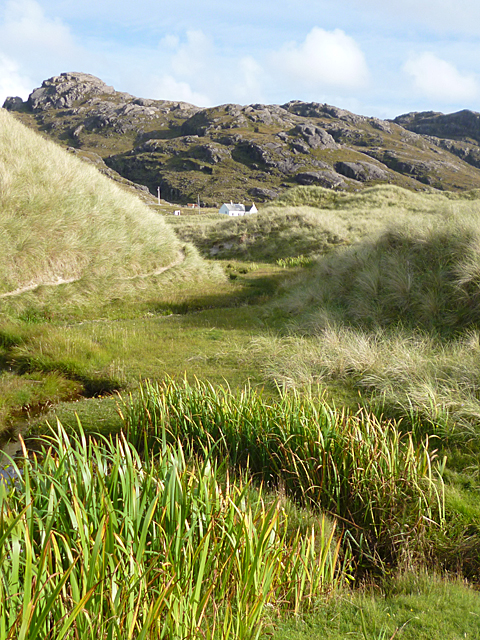NM4469 : Among the Sand Dunes
taken 11 years ago, near to Sanna, Highland, Scotland

Eucrite is a term formerly used for a type of rock formally called olivine bytownite gabbro in the Hebridean Igneous Province. Although the word eucrite is no longer considered to be the correct terminology, 'Great Eucrite' is used informally by geologists as a convenient term for the ring of gabbro hills that are such a prominent feature of the landscape of Ardnamurchan.
Gabbro is an igneous rock, but not a volcanic one because it was not erupted on the surface of the Earth. It forms deep in the crust, where molten magma cools slowly and there is time for large crystals to form, resulting in a very hard, dense, coarse-grained rock. This rock is very resistant to erosion, which is why the 'Great Eucrite' has survived glaciation better than the rest of the volcanic complex, and stands proud as an almost circular rampart of hills.
The youngest of three successive volcanic centres in Ardnamurchan is referred to as Centre 3. It consists of a number of ring-shaped outcrops, of which the 'Great Eucrite' is the outermost. These outcrops are the ends of a series of intrusive structures, most of which dip inwards towards the centre of the ring, and are considered to be the result of sagging in the centre of the volcano and subsequent erosion. A reasonable analogy for the circular outcrops of Ardnamurchan would be a pile of bowls stacked on top of one another, each bowl smaller in diameter than the one below it. The rims of the bowls will look like a succession of ever-smaller circles, much like the geological map of Ardnamurchan.
The term 'ring-dyke' has sometimes been used in the past to describe the units making up Centre 3, but since the 1950s various authors have pointed out that most of them, and in particular the 'Great Eucrite', do not conform to the definition of a ring-dyke either in shape or in their mode of formation. A ring-dyke is a thin circle of intruded rock, rather like the shape of an upside-down bucket without its base, dipping outwards around the centre of a volcano and cutting across other units of rock. Ring-dykes are formed when cracks form around a sagging volcanic centre, and the cracks are filled in by molten magma rising from below.
There is a true outward-dipping ring-dyke inside the ring of the 'Great Eucrite' but it is concealed by soil and vegetation and does not form a readily recognisable feature on the ground.
